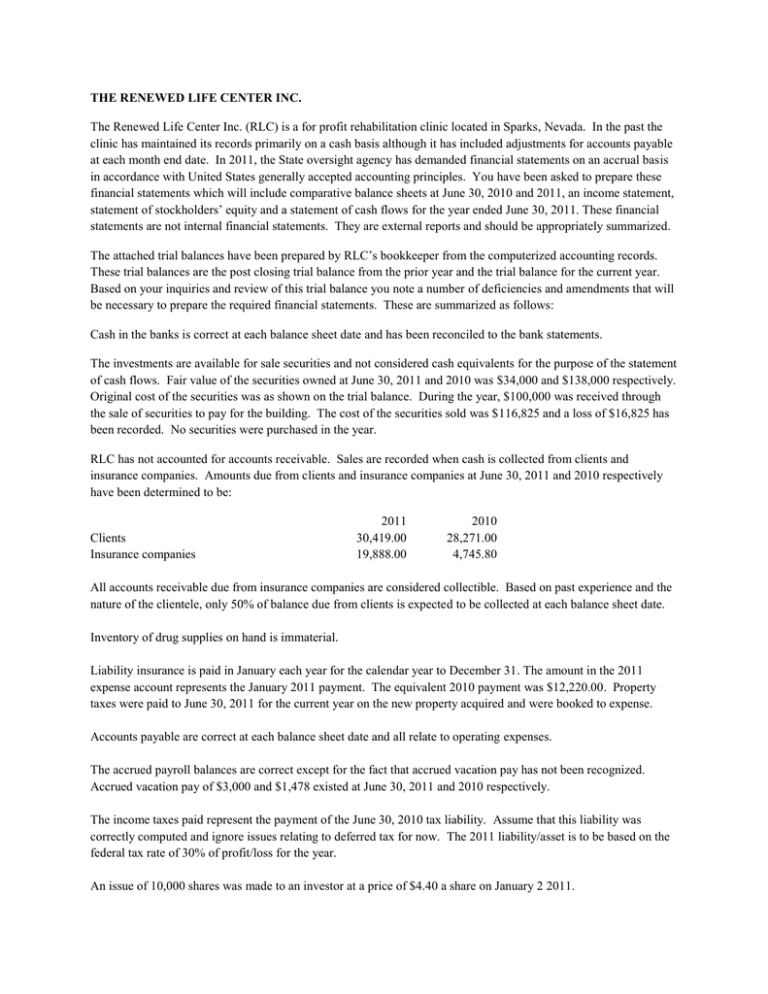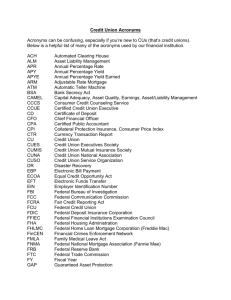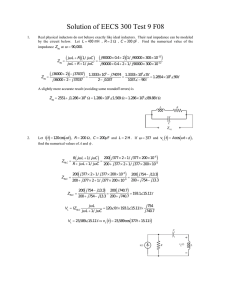the_renewed_life_center_inc
advertisement

THE RENEWED LIFE CENTER INC. The Renewed Life Center Inc. (RLC) is a for profit rehabilitation clinic located in Sparks, Nevada. In the past the clinic has maintained its records primarily on a cash basis although it has included adjustments for accounts payable at each month end date. In 2011, the State oversight agency has demanded financial statements on an accrual basis in accordance with United States generally accepted accounting principles. You have been asked to prepare these financial statements which will include comparative balance sheets at June 30, 2010 and 2011, an income statement, statement of stockholders’ equity and a statement of cash flows for the year ended June 30, 2011. These financial statements are not internal financial statements. They are external reports and should be appropriately summarized. The attached trial balances have been prepared by RLC’s bookkeeper from the computerized accounting records. These trial balances are the post closing trial balance from the prior year and the trial balance for the current year. Based on your inquiries and review of this trial balance you note a number of deficiencies and amendments that will be necessary to prepare the required financial statements. These are summarized as follows: Cash in the banks is correct at each balance sheet date and has been reconciled to the bank statements. The investments are available for sale securities and not considered cash equivalents for the purpose of the statement of cash flows. Fair value of the securities owned at June 30, 2011 and 2010 was $34,000 and $138,000 respectively. Original cost of the securities was as shown on the trial balance. During the year, $100,000 was received through the sale of securities to pay for the building. The cost of the securities sold was $116,825 and a loss of $16,825 has been recorded. No securities were purchased in the year. RLC has not accounted for accounts receivable. Sales are recorded when cash is collected from clients and insurance companies. Amounts due from clients and insurance companies at June 30, 2011 and 2010 respectively have been determined to be: Clients Insurance companies 2011 30,419.00 19,888.00 2010 28,271.00 4,745.80 All accounts receivable due from insurance companies are considered collectible. Based on past experience and the nature of the clientele, only 50% of balance due from clients is expected to be collected at each balance sheet date. Inventory of drug supplies on hand is immaterial. Liability insurance is paid in January each year for the calendar year to December 31. The amount in the 2011 expense account represents the January 2011 payment. The equivalent 2010 payment was $12,220.00. Property taxes were paid to June 30, 2011 for the current year on the new property acquired and were booked to expense. Accounts payable are correct at each balance sheet date and all relate to operating expenses. The accrued payroll balances are correct except for the fact that accrued vacation pay has not been recognized. Accrued vacation pay of $3,000 and $1,478 existed at June 30, 2011 and 2010 respectively. The income taxes paid represent the payment of the June 30, 2010 tax liability. Assume that this liability was correctly computed and ignore issues relating to deferred tax for now. The 2011 liability/asset is to be based on the federal tax rate of 30% of profit/loss for the year. An issue of 10,000 shares was made to an investor at a price of $4.40 a share on January 2 2011. Property plant and equipment and the related liabilities are messed up. Depreciation has never been booked and the new building and related loans have not been accounted for correctly. A depreciation schedule through to June 30, 2010 has been provided for your use. In July 2010 RLC purchased land and buildings for a total amount of $530,000. The purchase was 100% financed through with two mortgages offered by the vendor; a first mortgage of $480,000 and a second mortgage of $50,000. Based on property tax valuations, the land portion of the acquisition was assessed to be $130,000 with the balance relating to the buildings. In the period from July through December 31, 2010, RLC continued to operate from its former leasehold premises while the new clinic was being refurbished. The cost of the building refurbishment was included in Construction Costs – new building. All of these should be capitalized. The building was finally completed in December 2010 and RLC terminated its lease and commenced operations from the new building. The mortgages call for equal quarterly payments due on March 31, June 30, September 30 and December 31 each year. These payments include interest at 5% per year on the first mortgage and 7% per year on the second mortgage. The mortgages were taken out on July 1, 2010 and four payments of $10,500 have been made on the first mortgage and four payments of $2,500 have been made on the second mortgage on time. These payments will continue for another 9 years (10 years from the start) at which time (July 1, 2020) the remaining mortgage principal will be fully repayable. Additions to equipment in 2011 were $25,726. Useful life for all equipment and the software system is an estimated five year life with no residual value. The building is estimated to have a forty year life with no residual value... A half year’s depreciation is taken in the year of acquisition and disposal. No fixed assets have been sold. The leasehold improvements reverted to the lessor at the termination of the lease in December 2011. 80% of the improvements should have been amortized at June 30, 2010 based on the five year lease term and the balance should be written off in the current year. In addition because of a dispute with the lessor concerning damage to the leased premises, the rent deposit which was thought to be recoverable at June 30, 2010 proved to be irrecoverable in 2011 and should be written off in 2011. TO DO THIS EXERCISE 1. Correct the opening trial balance to determine the figures needed for the opening balance sheet. 2. Enter the correcting entries for the prior year items in the current year trial balance. (These will be in the nature of prior period adjustments). 3. Correct the closing trial balance with the required current period adjustments. 4. Prepare the financial statements. This exercise must be done using your excel skills. It is not a manual exercise.











